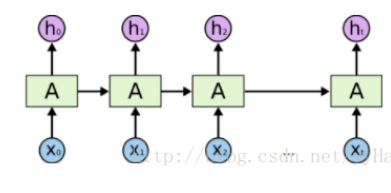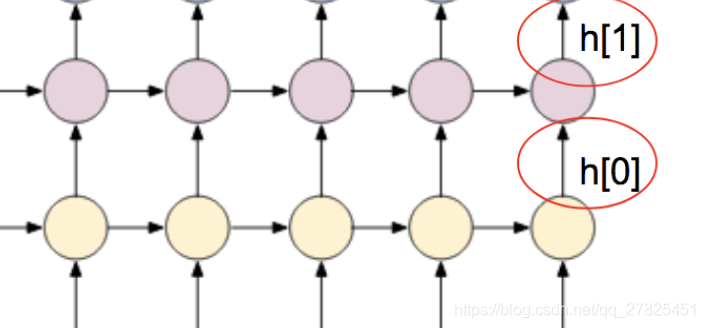默認只返回最后一個state,所以一次輸入一個step的input
|
1
2
3
4
5
6
7
8
9
10
11
12
13
14
15
16
17
18
19
20
21
22
23
24
|
# coding=UTF-8import torchimport torch.autograd as autograd # torch中自動計算梯度模塊import torch.nn as nn # 神經網絡模塊torch.manual_seed(1)# lstm單元輸入和輸出維度都是3lstm = nn.LSTM(input_size=3, hidden_size=3)# 生成一個長度為5,每一個元素為1*3的序列作為輸入,這里的數字3對應于上句中第一個3inputs = [autograd.Variable(torch.randn((1, 3))) for _ in range(5)]# 設置隱藏層維度,初始化隱藏層的數據hidden = (autograd.Variable(torch.randn(1, 1, 3)), autograd.Variable(torch.randn((1, 1, 3))))for i in inputs: out, hidden = lstm(i.view(1, 1, -1), hidden) print(out.size()) print(hidden[0].size()) print("--------")print("-----------------------------------------------")# 下面是一次輸入多個step的樣子inputs_stack = torch.stack(inputs)out,hidden = lstm(inputs_stack,hidden)print(out.size())print(hidden[0].size()) |
print結果:
(1L, 1L, 3L)
(1L, 1L, 3L)
--------
(1L, 1L, 3L)
(1L, 1L, 3L)
--------
(1L, 1L, 3L)
(1L, 1L, 3L)
--------
(1L, 1L, 3L)
(1L, 1L, 3L)
--------
(1L, 1L, 3L)
(1L, 1L, 3L)
--------
----------------------------------------------
(5L, 1L, 3L)
(1L, 1L, 3L)
可見LSTM的定義都是不用變的,根據input的step數目,一次輸入多少step,就一次輸出多少output,但只輸出最后一個state
補充:pytorch中實現循環神經網絡的基本單元RNN、LSTM、GRU的輸入、輸出、參數詳細理解
前言:這篇文章是對已經較為深入理解了RNN、LSTM、GRU的數學原理以及運算過程的人而言的,如果不理解它的基本思想和過程,可能理解起來不是很簡單。
一、先從一個實例看起
這是官網上面的一個例子,本次以LSTM作為例子而言,實際上,GRU、LSTM、RNN的運算過程是很類似的。
|
1
2
3
4
5
6
7
8
9
10
11
12
13
14
15
16
17
18
19
20
21
22
23
|
import torchimport torch.nn as nn lstm = nn.LSTM(10, 20, 2) # 序列長度seq_len=5, batch_size=3, 數據向量維數=10input = torch.randn(5, 3, 10) # 初始化的隱藏元和記憶元,通常它們的維度是一樣的# 2個LSTM層,batch_size=3,隱藏元維度20h0 = torch.randn(2, 3, 20)c0 = torch.randn(2, 3, 20) # 這里有2層lstm,output是最后一層lstm的每個詞向量對應隱藏層的輸出,其與層數無關,只與序列長度相關# hn,cn是所有層最后一個隱藏元和記憶元的輸出output, (hn, cn) = lstm(input, (h0, c0)) print(output.size(),hn.size(),cn.size()) # 分別是:# torch.Size([5, 3, 20])# torch.Size([2, 3, 20])# torch.Size([2, 3, 20])) |
后面我會詳細解釋上面的運算過程,我們先看一下LSTM的定義,它是一個類
二、LSTM類的定義
|
1
2
3
4
5
6
7
8
9
10
11
12
13
14
15
16
17
18
19
20
21
22
23
24
25
26
27
28
29
30
31
32
33
34
35
36
37
38
39
40
41
42
43
44
45
46
47
48
49
50
51
52
53
54
55
56
|
class LSTM(RNNBase): '''參數Args: input_size: 輸入數據的特征維度,比如我對時間序列建模,特征為1,我對一個句子建模,每一個單詞的嵌入向量為10,則它為10 hidden_size: 即循環神經網絡中隱藏節點的個數,這個是自己定義的,多少都可以,后面會詳說 num_layers: 堆疊的LSTM的層數,默認是一層,也可以自己定義 Default: 1 bias: LSTM層是否使用偏置矩陣 偏置權值為 `b_ih` and `b_hh`. Default: ``True``(默認是使用的) batch_first: 如果設置 ``True``, then the input and output tensors are provided as (batch, seq, feature). Default: ``False``,(seq,batch,features) dropout: 是否使用dropout機制,默認是0,表示不使用dropout,如果提供一個非0的數字,則表示在每一個LSTM層之后默認使用dropout,但是最后一個層的LSTM層不使用dropout。 bidirectional: 是否是雙向RNN,默認是否,If ``True``, becomes a bidirectional LSTM. Default: ``False``#--------------------------------------------------------------------------------------- 類的構造函數的輸入為Inputs: input, (h_0, c_0) - **input** of shape `(seq_len, batch, input_size)`: tensor containing the features of the input sequence. - **h_0** of shape `(num_layers * num_directions, batch, hidden_size)`: tensor containing the initial hidden state for each element in the batch. If the LSTM is bidirectional, num_directions should be 2, else it should be 1. - **c_0** of shape `(num_layers * num_directions, batch, hidden_size)`: tensor containing the initial cell state for each element in the batch. If `(h_0, c_0)` is not provided, both **h_0** and **c_0** default to zero.#---------------------------------------------------------------------------------- 輸出是什么:Outputs: output, (h_n, c_n) - **output** of shape `(seq_len, batch, num_directions * hidden_size)`: tensor containing the output features `(h_t)` from the last layer of the LSTM, for each `t`. If a :class:`torch.nn.utils.rnn.PackedSequence` has been given as the input, the output will also be a packed sequence. For the unpacked case, the directions can be separated using ``output.view(seq_len, batch, num_directions, hidden_size)``, with forward and backward being direction `0` and `1` respectively. Similarly, the directions can be separated in the packed case. - **h_n** of shape `(num_layers * num_directions, batch, hidden_size)`: tensor containing the hidden state for `t = seq_len`. Like *output*, the layers can be separated using ``h_n.view(num_layers, num_directions, batch, hidden_size)`` and similarly for *c_n*. - **c_n** of shape `(num_layers * num_directions, batch, hidden_size)`: tensor containing the cell state for `t = seq_len`.#------------------------------------------------------------------------------------------ 類的屬性有Attributes: weight_ih_l[k] : the learnable input-hidden weights of the :math:`\text{k}^{th}` layer `(W_ii|W_if|W_ig|W_io)`, of shape `(4*hidden_size, input_size)` for `k = 0`. Otherwise, the shape is `(4*hidden_size, num_directions * hidden_size)` weight_hh_l[k] : the learnable hidden-hidden weights of the :math:`\text{k}^{th}` layer `(W_hi|W_hf|W_hg|W_ho)`, of shape `(4*hidden_size, hidden_size)` bias_ih_l[k] : the learnable input-hidden bias of the :math:`\text{k}^{th}` layer `(b_ii|b_if|b_ig|b_io)`, of shape `(4*hidden_size)` bias_hh_l[k] : the learnable hidden-hidden bias of the :math:`\text{k}^{th}` layer `(b_hi|b_hf|b_hg|b_ho)`, of shape `(4*hidden_size)` ''' |
上面的參數有點多,我就不一個一個翻譯了,其實很好理解,每一個都比較清晰。
三、 必需參數的深入理解
1、RNN、GRU、LSTM的構造函數的三個必須參數理解——第一步:構造循環層對象
在創建循環層的時候,第一步是構造循環層,如下操作:
|
1
|
lstm = nn.LSTM(10, 20, 2) |
構造函數的參數列表為如下:
|
1
2
3
4
5
6
7
8
9
10
11
|
class LSTM(RNNBase): '''參數Args: input_size: hidden_size: num_layers: bias: batch_first: dropout: bidirectional: ''' |
(1)input_size:指的是每一個單詞的特征維度,比如我有一個句子,句子中的每一個單詞都用10維向量表示,則input_size就是10;
(2)hidden_size:指的是循環層中每一個LSTM內部單元的隱藏節點數目,這個是自己定義的,隨意怎么設置都可以;
(3)num_layers:循環層的層數,默認是一層,這個根據自己的情況來定。
比如下面:


左邊的只有一層循環層,右邊的有兩層循環層。
2、通過第一步構造的對象構造前向傳播的過程——第二步:調用循環層對象,傳入參數,并得到返回值
一般如下操作:
|
1
|
output, (hn, cn) = lstm(input, (h0, c0)) |
這里是以LSTM為例子來說的,
(1)輸入參數
input:必須是這樣的格式(seq,batch,feature)。第一個seq指的是序列的長度,這是根據自己的數據來定的,比如我的一個句子最大的長度是20個單詞組成,那這里就是20,上面的例子是假設句子長度為5;第二個是batch,這個好理解,就是一次使用幾條樣本,比如3組樣本;第三個features指的是每一個單詞的向量維度,需要注意的是,這個必須要和構造函數的第一個參數input_size保持一樣的,上面的例子中是10.
(h0,c0):指的是每一個循環層的初始狀態,可以不指定,不指定的情況下全部初始化為0,這里因為是LSTM有兩個狀態需要傳遞,所以有兩個,像普通的RNN和GRU只有一個狀態需要傳遞,則只需要傳遞一個h狀態即可,如下:
|
1
2
|
output, hn = rnn(input, h0) # 普通rnnoutput, hn = gru(input, h0) # gru |
這里需要注意的是傳入的狀態參數的維度,依然以LSTM來說:
h0和c0的數據維度均是(num_layers * num_directions, batch, hidden_size),這是什么意思呢?
第一個num_layer指的是到底有基層循環層,這好理解,幾層就應該有幾個初始狀態;
第二個num_directions指的是這個循環層是否是雙向的(在構造函數中通過bidirectional參數指定哦),如果不是雙向的,則取值為1,如果是雙向的則取值為2;
第三個batch指的是每次數據的batch,和前面的batch保持一致即可;
最后一個hidden_size指的是循環層每一個節點內部的隱藏節點數,這個需要很好地理解循環神經網絡的整個運算流程才行哦!
(2)輸出結果
其實輸出的結果和輸入的是相匹配的,分別如下:
|
1
2
3
|
output, hn = rnn(input, h0) # 普通rnnoutput, hn = gru(input, h0) # gruoutput, (hn, cn) = lstm(input, (h0, c0)) # lstm |
這里依然以lstm而言:
output的輸出維度:(seq_len, batch, num_directions * hidden_size),在上面的例子中,應該為(5,3,20),我們通過驗證的確如此,需要注意的是,第一個維度是seq_len,也就是說每一個時間點的輸出都是作為輸出結果的,這和隱藏層是不一樣的;
hn、cn的輸出維度:為(num_layers * num_directions, batch, hidden_size),在上面的例子中為(2,3,20),也得到了驗證,我們發現這個跟序列長度seq_len是沒有關系的,為什么呢,輸出的狀態僅僅是指的是最后一個循環層節點輸出的狀態。
如下圖所示:
下面的例子是以普通的RNN來畫的,所以只有一個狀態h,沒有狀態c。

3、幾個重要的屬性理解
不管是RNN,GRU還是lstm,內部可學習的參數其實就是幾個權值矩陣,包括了偏置矩陣,那怎么查看這些學習到的參數呢?就是通過這幾個矩陣來實現的
(1)weight_ih_l[k]:這表示的是輸入到隱藏層之間的權值矩陣,其中K表示的第幾層循環層,
若K=0,表示的是最下面的輸入層到第一個循環層之間的矩陣,維度為(hidden_size, input_size),如果k>0則表示第一循環層到第二循環層、第二循環層到第三循環層,以此類推,之間的權值矩陣,形狀為(hidden_size, num_directions * hidden_size)。
(2)weight_hh_l[k]: 表示的是循環層內部之間的權值矩陣,這里的K表示的第幾層循環層,取值為0,1,2,3,4... ...。形狀為(hidden_size, hidden_size)
注意:循環層的層數取值是從0開始,0代表第一個循環層,1代表第二個循環層,以此類推。
(3)bias_ih_l[k]: 第K個循環層的偏置項,表示的是輸入到循環層之間的偏置,維度為 (hidden_size)
(4)bias_hh_l[k]:第K個循環層的偏置項,表示的是循環層到循環層內部之間的偏置,維度為 (hidden_size)。
|
1
2
3
4
5
6
7
8
9
10
11
12
13
14
15
16
17
18
19
20
21
22
23
24
25
26
27
28
29
30
31
32
33
34
35
36
37
38
39
40
41
42
43
44
|
# 首先導入RNN需要的相關模塊import torchimport torch.nn as nn # 數據向量維數10, 隱藏元維度20, 2個RNN層串聯(如果是1,可以省略,默認為1)rnn = nn.RNN(10, 20, 2) # 序列長度seq_len=5, batch_size=3, 數據向量維數=10input = torch.randn(5, 3, 10) # 初始化的隱藏元和記憶元,通常它們的維度是一樣的# 2個RNN層,batch_size=3,隱藏元維度20h0 = torch.randn(2, 3, 20) # 這里有2層RNN,output是最后一層RNN的每個詞向量對應隱藏層的輸出,其與層數無關,只與序列長度相關# hn,cn是所有層最后一個隱藏元和記憶元的輸出output, hn = rnn(input, h0) print(output.size(),hn.size()) # 分別是:torch.Size([5, 3, 20]) torch.Size([2, 3, 20]) # 查看一下那幾個重要的屬性:print("------------輸入--》隱藏------------------------------")print(rnn.weight_ih_l0.size()) print(rnn.weight_ih_l1.size())print(rnn.bias_ih_l0.size())print(rnn.bias_ih_l1.size())print("------------隱藏--》隱藏------------------------------")print(rnn.weight_hh_l0.size()) print(rnn.weight_hh_l1.size())print(rnn.bias_hh_l0.size())print(rnn.bias_hh_l1.size()) '''輸出結果為:------------輸入--》隱藏------------------------------torch.Size([20, 10])torch.Size([20, 20])torch.Size([20])torch.Size([20])------------隱藏--》隱藏------------------------------torch.Size([20, 20])torch.Size([20, 20])torch.Size([20])torch.Size([20])''' |
通過上面的運算,發現結果和描述的是一模一樣的。
以上為個人經驗,希望能給大家一個參考,也希望大家多多支持服務器之家。
原文鏈接:https://guotong1988.blog.csdn.net/article/details/79708099










